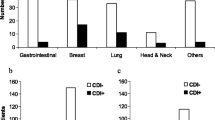Abstract
Purpose
The purpose of the study was to determine if a diagnosis of ovarian cancer is independently associated with an increased risk of Clostridium difficile infection (CDI).
Methods
The University HealthSystem Consortium database was queried to perform a retrospective cohort study of women with and without ovarian cancer who were diagnosed with CDI. Inpatients undergoing total hysterectomy from 2008 to 2012 were studied. Ovarian cancer patients were compared to non-ovarian cancer patients to evaluate relative risk (RR) of CDI. Adjustment was made for known or suspected CDI risk factors to determine RR of CDI independent of these variables.
Results
In this study, 115,203 patients were included. CDI was reported in 0.80 % of ovarian cancer patients and in 0.31 % of non-ovarian cancer patients (RR = 2.50; 95 % confidence interval (CI) = 2.02 to 3.35). Stratification by age, presence of other comorbidities, or administration of antineoplastic drugs did not significantly modify the elevated risk associated with ovarian cancer. Significantly increased risk in ovarian cancer patients was no longer observed after controlling for broad-spectrum antibiotic administration (RR = 1.28, 95 % CI = 0.39 to 4.13). Compared to non-ovarian cancer patients, ovarian cancer patients were more frequently treated with broad-spectrum antibiotics, had a 39 % longer mean duration of therapy, and had 2.5-fold greater mean total exposure to broad-spectrum antibiotics.
Conclusions
After adjustment for antibiotic use, ovarian cancer patients are not at excess risk of CDI. Additional studies are needed to understand the patterns of broad-spectrum antibiotic prescription for ovarian cancer patients leading to increased exposure. If feasible, reduction of this exposure may decrease morbidity in this population.
Similar content being viewed by others
References
Lipp MJ, Nero DC, Callahan MA (2012) Impact of hospital-acquired Clostridium difficile. J Gastroenterol Hepatol 27(11):1733–1737. doi:10.1111/j.1440-1746.2012.07242.x
Kyne L, Sougioultzis S, McFarland LV, Kelly CP (2002) Underlying disease severity as a major risk factor for nosocomial Clostridium difficile diarrhea. Infect Control Hosp Epidemiol 23(11):653–659. doi:10.1086/501989
Kelly CP, Pothoulakis C, LaMont JT (1994) Clostridium difficile colitis. N Engl J Med 330(4):257–262. doi:10.1056/nejm199401273300406
Ricciardi R, Rothenberger DA, Madoff RD, Baxter NN (2007) Increasing prevalence and severity of Clostridium difficile colitis in hospitalized patients in the United States. Arch Surg 142(7):624–631. doi:10.1001/archsurg.142.7.624
Zerey M, Paton BL, Lincourt AE, Gersin KS, Kercher KW, Heniford BT (2007) The burden of Clostridium difficile in surgical patients in the United States. Surg Infect (Larchmt) 8(6):557–566. doi:10.1089/sur.2006.062
Lo Vecchio A, Zacur GM (2012) Clostridium difficile infection: an update on epidemiology, risk factors, and therapeutic options. Curr Opin Gastroenterol 28(1):1–9. doi:10.1097/MOG.0b013e32834bc9a9
McCollum DL, Rodriguez JM (2012) Detection, treatment, and prevention of Clostridium difficile infection. Clin Gastroenterol Hepatol 10(6):581–592. doi:10.1016/j.cgh.2012.03.008
Hensgens MP, Goorhuis A, Dekkers OM, Kuijper EJ (2012) Time interval of increased risk for Clostridium difficile infection after exposure to antibiotics. J Antimicrob Chemother 67(3):742–748. doi:10.1093/jac/dkr508
Owens RC Jr, Donskey CJ, Gaynes RP, Loo VG, Muto CA (2008) Antimicrobial-associated risk factors for Clostridium difficile infection. Clin Infect Dis 46(Suppl 1):S19–31. doi:10.1086/521859
Wistrom J, Norrby SR, Myhre EB, Eriksson S, Granstrom G, Lagergren L, Englund G, Nord CE, Svenungsson B (2001) Frequency of antibiotic-associated diarrhoea in 2462 antibiotic-treated hospitalized patients: a prospective study. J Antimicrob Chemother 47(1):43–50. doi:10.1093/jac/47.1.43
Dubberke ER, Reske KA, Yan Y, Olsen MA, McDonald LC, Fraser VJ (2007) Clostridium difficile-associated disease in a setting of endemicity: identification of novel risk factors. Clin Infect Dis 45(12):1543–1549. doi:10.1086/523582
Emoto M, Kawarabayashi T, Hachisuga MD, Eguchi F, Shirakawa K (1996) Clostridium difficile colitis associated with cisplatin-based chemotherapy in ovarian cancer patients. Gynecol Oncol 61(3):369–372
Masciullo V, Mainenti S, Lorusso D, Margariti PA, Scambia G (2010) Lethal Clostridium difficile colitis associated with paclitaxel and carboplatin chemotherapy in ovarian carcinoma: case report and review of the literature. Obstet Gynecol Int 2010. doi:10.1155/2010/74978
Southern WN, Rahmani R, Aroniadis O, Khorshidi I, Thanjan A, Ibrahim C, Brandt LJ (2010) Postoperative Clostridium difficile-associated diarrhea. Surgery 148(1):24–30. doi:10.1016/j.surg.2009.11.021
Carignan A, Allard C, Pepin J, Cossette B, Nault V, Valiquette L (2008) Risk of Clostridium difficile infection after perioperative antibacterial prophylaxis before and during an outbreak of infection due to a hypervirulent strain. Clin Infect Dis 46(12):1838–1843. doi:10.1086/588291
Fowler S, Webber A, Cooper BS, Phimister A, Price K, Carter Y, Kibbler CC, Simpson AJ, Stone SP (2007) Successful use of feedback to improve antibiotic prescribing and reduce Clostridium difficile infection: a controlled interrupted time series. J Antimicrob Chemother 59(5):990–995. doi:10.1093/jac/dkm014
Talpaert MJ, Gopal Rao G, Cooper BS, Wade P (2011) Impact of guidelines and enhanced antibiotic stewardship on reducing broad-spectrum antibiotic usage and its effect on incidence of Clostridium difficile infection. J Antimicrob Chemother 66(9):2168–2174. doi:10.1093/jac/dkr253
Aldeyab MA, Kearney MP, Scott MG, Aldiab MA, Alahmadi YM, Darwish Elhajji FW, Magee FA, McElnay JC (2012) An evaluation of the impact of antibiotic stewardship on reducing the use of high-risk antibiotics and its effect on the incidence of Clostridium difficile infection in hospital settings. J Antimicrob Chemother 67(12):2988–2996. doi:10.1093/jac/dks330
Conflict of interest
The authors have no conflicts of interest to disclose.
Author information
Authors and Affiliations
Corresponding author
Rights and permissions
About this article
Cite this article
Kim, J.S., Ward, K.K., Shah, N.R. et al. Excess risk of Clostridium difficile infection in ovarian cancer is related to exposure to broad-spectrum antibiotics. Support Care Cancer 21, 3103–3107 (2013). https://doi.org/10.1007/s00520-013-1888-2
Received:
Accepted:
Published:
Issue Date:
DOI: https://doi.org/10.1007/s00520-013-1888-2



